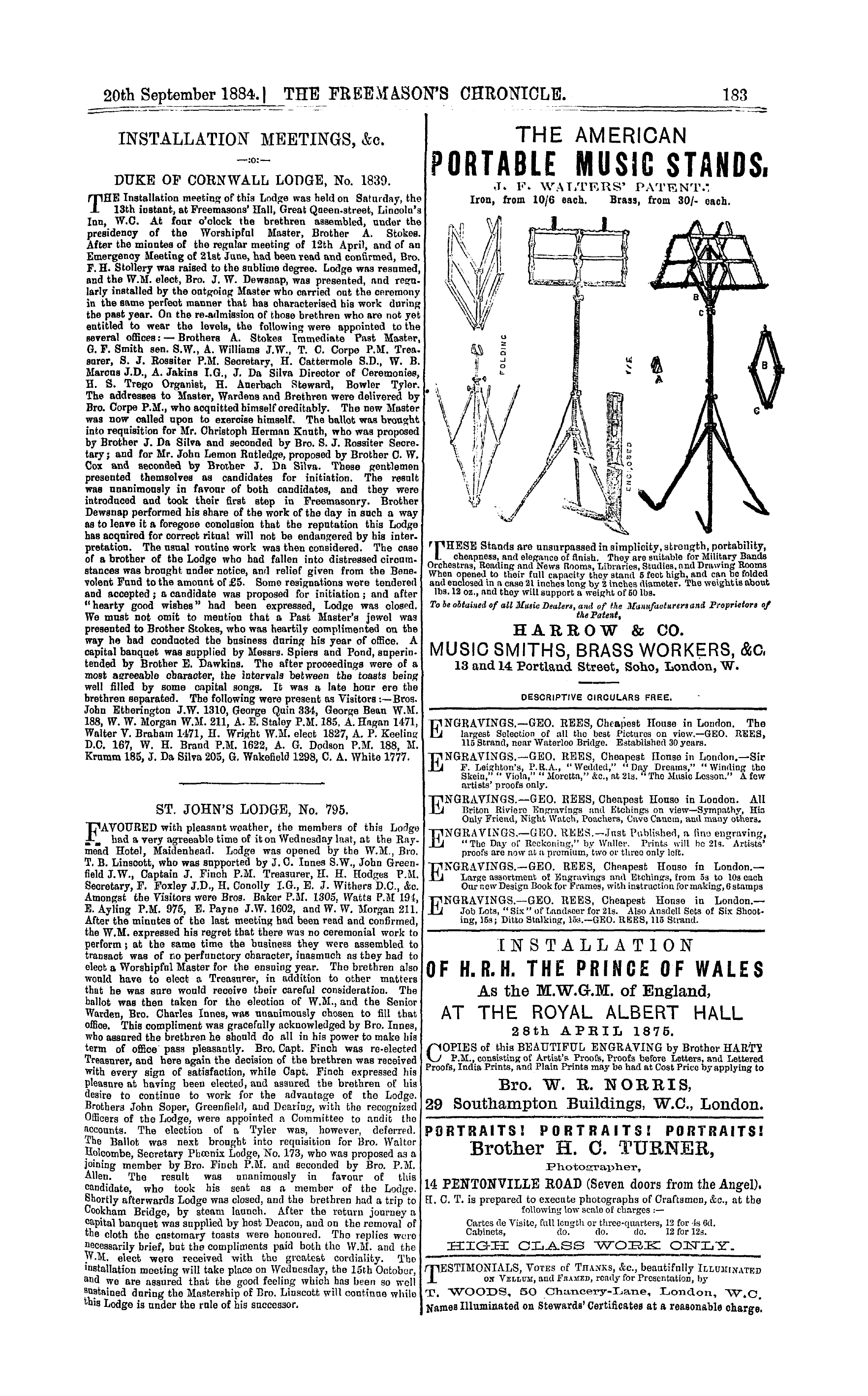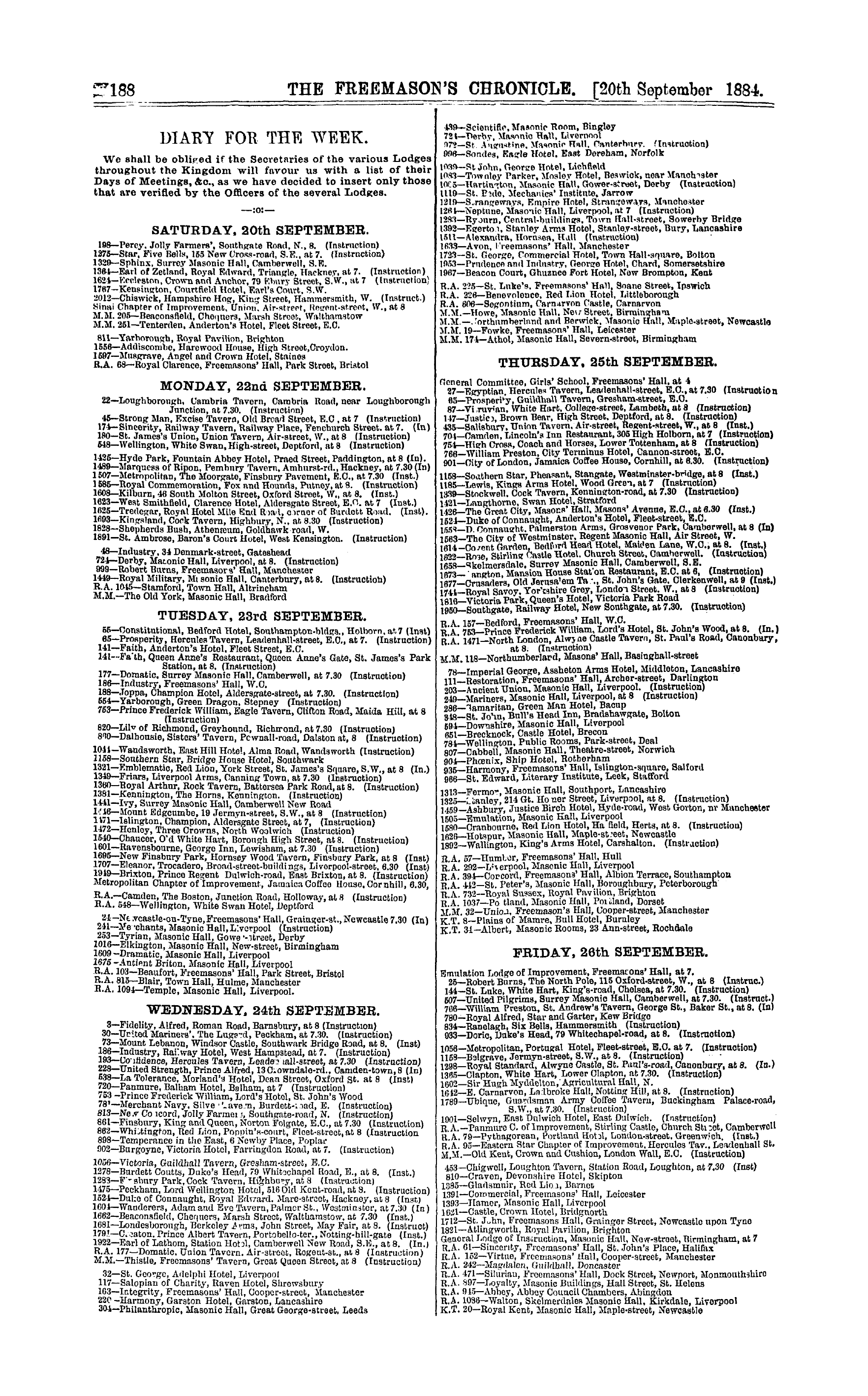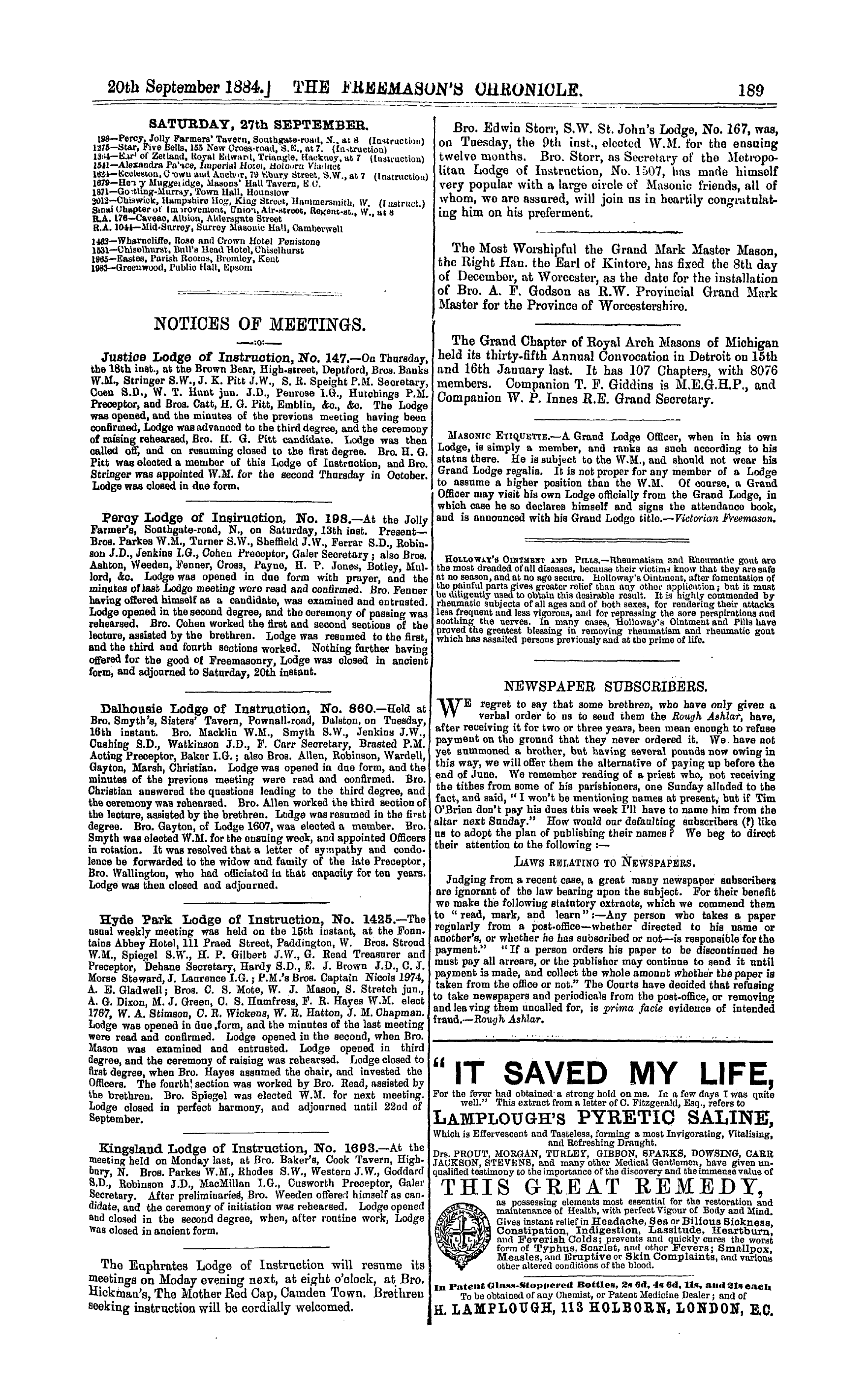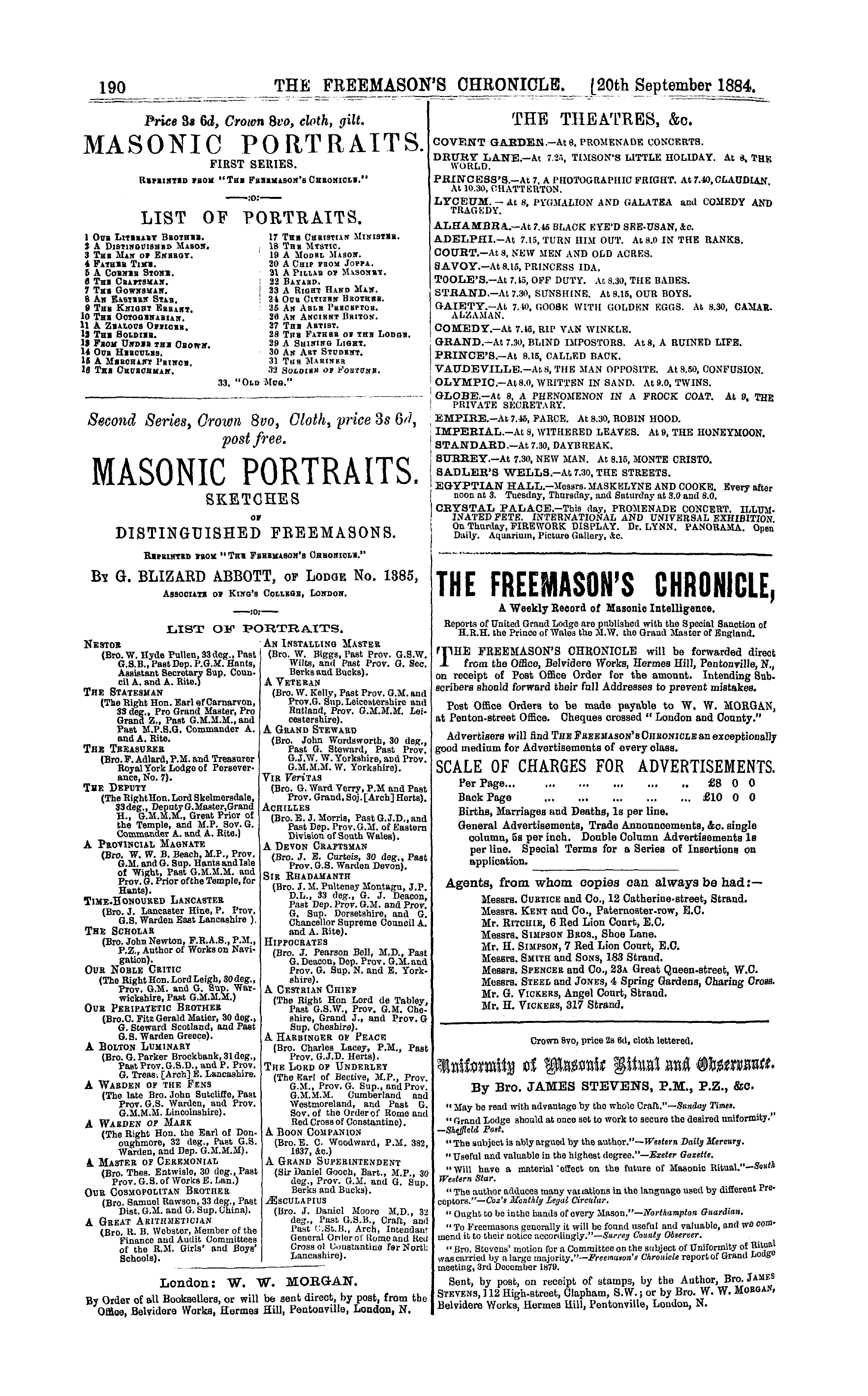-
Articles/Ads
Article THE ENGLISH RITE OF FREEMASONRY. ← Page 2 of 2 Article RIGHTNESS. Page 1 of 3 Article RIGHTNESS. Page 1 of 3 →
Note: This text has been automatically extracted via Optical Character Recognition (OCR) software.
The English Rite Of Freemasonry.
the kind , or of some other kind , but still esoteric , in existence . Again , we would ask , if there was before 1717 the same triplex division as there is now , why Grand Lodge should have reserved to itself , for some years after its establishment , the right of conferring the Master ' s
degree , if there had been before the era of Grand Lodge any esoteric ceremonies connected with it ? And why agaiu should thero havo been Master Masons ' Lodges , as noted by Bro . Hughan , in 1733 , if for years and years before that date there had been some ceremony
attached to the Degree as there is now ? No doubt the object of these Master Masons' Lodges was to practise the working of the Degree , which at tho time was becoming move and more common , in tbe sense of ' mote and more ' frequently taken ? The more closely we examine into the
subject , the more convinced are we of the accuracy of the views pronounced by Hughan , Lyon , Gould , and other authorities , and that Bro . Woodford has had the misfortune —it is not often he is so circumstanced—to pronounce an erroneous judgment in this question of Degrees . As is the
case with Hughan , so it is with us , we are not prejudiced in favour of or against any particular theory , and if Bro . Woodford can at any time produce evidence sufficiently convincing to change our present opinion , we shall gladly make him the only honourable amends in our power by announcing our adhesion to his views .
The Chapter entitled " Investigations on the Third Degree " must be looked upon as supplementary to that we have been considering . The information it contains has been gathered from diverse sources and is most interesting , as will be seen when we enter upon our next article . ( To be continued . )
Rightness.
RIGHTNESS .
DOGMA OF THE MARK MASTER ' S DEGREE . A LARGE majority of those who are advanced to the " more honourable degree of Mark Master " look upon the first section of it as a reality ; that the several incidents of inspection , rejection , detection , & c , & c , are
all true , and that during the erection of the temple of Solomon it was the custom invariably for the craftsmen , at the close of the week , to personally present the result of their labours to the several Overseers for inspection .
A moment ' s reflection must satisfy every one of the utter impracticability of the realism of the events thus dramatically represented . Like every degree in Masonry , in all the various rites , those who invented this degree designed to convey to the minds of the postulants very
important lessons . After much careful investigation we think the principal feature of the Mark degree , and the dogma , is that of honesty or Tightness . That every Mason should , in the work of this life , be carefnl that what he presents for inspection , either general or particular , has
been wrought out entirely by himself , and is , therefore , his own . Let us follow , step by step , this allegorical representation , as far as we are permitted , without exposing to the world any mysteries contained therein . First . The true form of the stones in this representation
was a cube ; this is the symbol of perfection . The sanchim sanctorum of the original tabernacle of Moses , and afteiward of the temple , was cubical . We may , therefore , suppose symbolically that the walls were composed entirely of cubical stones . To the ancients the cubical
form represented truth , perfection , completeness . Josephus aays the Holy of Holies from its form represented heaven , while tbe sanctuary or holy place being in length double its width , represented the earth , as at his day the Ptolemaic cosmography represented the earth as
bemoan oblong plain—twice as long east and west as it was north and south . John , in Revelation , chapter xxi . 16 , describes heaven as being cubical in form , evidently
figuratively expressive of perfection . The pattern , therefore , by which , in this degree , each Craftsman was to finish his work was a " true square ; " the common term ancientl y for what we now denominate " a cube . " The Overseers
were commanded to receive no other work ; hence , if an oblong block should be presented it must be rejected by them . The three several inspections would seem to have been
Rightness.
unnecessary for a material building ; but aUegorically re . present to our mind very important considerations . The sixth hour of the sixth day was the closing of the week , which symbolised the closing of a life . In this life every individual has set for him a " life-task . " That task is to
fit himself as a " living stone " for the " spiritual temple . " The rules laid down in tho great books of nature and revelation all indicate that life-work should be " good , beautiful and true , " that is , it should be perfectly conformable at all its angles to the " square of virtue " of the Fellow
Craft . The person himself , boing a " Craftsman , hashad the " square of virtue " presented to him as a working tool ; also as an Entered Apprentice has professed " faith in GOD , " and as a Master Mason , has been taught the immortality of the soul and the resurrection of the body , and therefore
has been fully instructed as to the rules and guides b y which he is expected to complete the " life-task " and fit himself for that " building eternal in the heavens . " The first inspection represents the opinion of the worldl y wise ; the second , a religions formalism , and the third , the spiritual tests . The candidate represents the man who in all his life
" has idled away his time , " so far as the preparation of the " life-work " is concerned . He may have sedulously devoted himself to business , so as to have accumulated a large fortune ; he may have become a scientist of the highest character ; the world may be full of his writings as a
" literateur ; " he may have been constantly engaged in statesmanshi p and in making laws for the government of the nation , yet when the hour has come for him to personally present his work for inspection , the religion or philosophy which is to demonstrate what was his diligence
in the prosecution of his " life-work " has been so neglected that he will " gather up " another's religion or philosophy and present it as his own work , ignorant of the " Marks " upon it , placed there by its author or inventor and known only to the initiated .
1 st . The inspection of the world at large would , although not according to the true law , pronounce it beautiful in workmanship , although singular in form , and pass it on . 2 nd . The inspection of " formalism " sees its beauty and singularity , and permits this specimen of religion and
philosophy to pass , becausefof its outward formalism ; but when the Master Overseer criticises the workmanship and the form , he pronounces it unfit for the work of the temple and it is finally rejected . Here ends the first lesson of the allegory .
The " foundation-stone " so often alluded to in the higher degrees is a " true square " or cube , —symbol of perfection .
The corner-stone which is to be laid with Masonic eeriemonies should invariably be a cube , and of such hard material that if every other part of the building should be crumbled into dust the corner or foundation-stone will remain as it was when first wrought into shape . To perform
the ceremony of laying a corner or foundation-stone is childishness , unless it be done from pure symbolism ; hence we should fully comprehend the symbolism . As the square angles around the stone symbolise virtue , and the cubical form represents truth—perfection ; so the foundation of
Masonry and the perfect character of every Mason is based on virtue and truth , which constitute perfection . In the article in June No . on the " Square of Virtue " or Fellow Craft ' s dogma , at the close we intimated that in a future number we might show what is the rule of RiGHTNESS .
We will now proceed to examine that question . Brightness being the supreme end of all moral action , or that which every one is morally compelled to follow , the question , What is Rightness ? must be correctly answered , or we may be found in continual error .
That which is conformable to any law is right . The word rectus implies that which is ruled or straight , according to some rule or standard . " Ethics and morals both imply in their very ori gin and etymology a way or lata , guiding and governing human conduct , and , therefore , of course ,
controlling moral conclusions . In all the workings of the moral nature there is recognised or implied a moral law under which the agent is placed , and which he is bound to obey . Rightness is found in obligatory conformity to this law . ' " Pursuing onr former plan of using the doctrine of
ethics , as laid down by the best authors , we freely use their writings to illustrate " our subject ; claiming no orig inality except in the application thereof . Examining this question we will consider : I . The Unsatisfactory Theories of the Supreme Rule . II . The True Theory of the Supreme
Note: This text has been automatically extracted via Optical Character Recognition (OCR) software.
The English Rite Of Freemasonry.
the kind , or of some other kind , but still esoteric , in existence . Again , we would ask , if there was before 1717 the same triplex division as there is now , why Grand Lodge should have reserved to itself , for some years after its establishment , the right of conferring the Master ' s
degree , if there had been before the era of Grand Lodge any esoteric ceremonies connected with it ? And why agaiu should thero havo been Master Masons ' Lodges , as noted by Bro . Hughan , in 1733 , if for years and years before that date there had been some ceremony
attached to the Degree as there is now ? No doubt the object of these Master Masons' Lodges was to practise the working of the Degree , which at tho time was becoming move and more common , in tbe sense of ' mote and more ' frequently taken ? The more closely we examine into the
subject , the more convinced are we of the accuracy of the views pronounced by Hughan , Lyon , Gould , and other authorities , and that Bro . Woodford has had the misfortune —it is not often he is so circumstanced—to pronounce an erroneous judgment in this question of Degrees . As is the
case with Hughan , so it is with us , we are not prejudiced in favour of or against any particular theory , and if Bro . Woodford can at any time produce evidence sufficiently convincing to change our present opinion , we shall gladly make him the only honourable amends in our power by announcing our adhesion to his views .
The Chapter entitled " Investigations on the Third Degree " must be looked upon as supplementary to that we have been considering . The information it contains has been gathered from diverse sources and is most interesting , as will be seen when we enter upon our next article . ( To be continued . )
Rightness.
RIGHTNESS .
DOGMA OF THE MARK MASTER ' S DEGREE . A LARGE majority of those who are advanced to the " more honourable degree of Mark Master " look upon the first section of it as a reality ; that the several incidents of inspection , rejection , detection , & c , & c , are
all true , and that during the erection of the temple of Solomon it was the custom invariably for the craftsmen , at the close of the week , to personally present the result of their labours to the several Overseers for inspection .
A moment ' s reflection must satisfy every one of the utter impracticability of the realism of the events thus dramatically represented . Like every degree in Masonry , in all the various rites , those who invented this degree designed to convey to the minds of the postulants very
important lessons . After much careful investigation we think the principal feature of the Mark degree , and the dogma , is that of honesty or Tightness . That every Mason should , in the work of this life , be carefnl that what he presents for inspection , either general or particular , has
been wrought out entirely by himself , and is , therefore , his own . Let us follow , step by step , this allegorical representation , as far as we are permitted , without exposing to the world any mysteries contained therein . First . The true form of the stones in this representation
was a cube ; this is the symbol of perfection . The sanchim sanctorum of the original tabernacle of Moses , and afteiward of the temple , was cubical . We may , therefore , suppose symbolically that the walls were composed entirely of cubical stones . To the ancients the cubical
form represented truth , perfection , completeness . Josephus aays the Holy of Holies from its form represented heaven , while tbe sanctuary or holy place being in length double its width , represented the earth , as at his day the Ptolemaic cosmography represented the earth as
bemoan oblong plain—twice as long east and west as it was north and south . John , in Revelation , chapter xxi . 16 , describes heaven as being cubical in form , evidently
figuratively expressive of perfection . The pattern , therefore , by which , in this degree , each Craftsman was to finish his work was a " true square ; " the common term ancientl y for what we now denominate " a cube . " The Overseers
were commanded to receive no other work ; hence , if an oblong block should be presented it must be rejected by them . The three several inspections would seem to have been
Rightness.
unnecessary for a material building ; but aUegorically re . present to our mind very important considerations . The sixth hour of the sixth day was the closing of the week , which symbolised the closing of a life . In this life every individual has set for him a " life-task . " That task is to
fit himself as a " living stone " for the " spiritual temple . " The rules laid down in tho great books of nature and revelation all indicate that life-work should be " good , beautiful and true , " that is , it should be perfectly conformable at all its angles to the " square of virtue " of the Fellow
Craft . The person himself , boing a " Craftsman , hashad the " square of virtue " presented to him as a working tool ; also as an Entered Apprentice has professed " faith in GOD , " and as a Master Mason , has been taught the immortality of the soul and the resurrection of the body , and therefore
has been fully instructed as to the rules and guides b y which he is expected to complete the " life-task " and fit himself for that " building eternal in the heavens . " The first inspection represents the opinion of the worldl y wise ; the second , a religions formalism , and the third , the spiritual tests . The candidate represents the man who in all his life
" has idled away his time , " so far as the preparation of the " life-work " is concerned . He may have sedulously devoted himself to business , so as to have accumulated a large fortune ; he may have become a scientist of the highest character ; the world may be full of his writings as a
" literateur ; " he may have been constantly engaged in statesmanshi p and in making laws for the government of the nation , yet when the hour has come for him to personally present his work for inspection , the religion or philosophy which is to demonstrate what was his diligence
in the prosecution of his " life-work " has been so neglected that he will " gather up " another's religion or philosophy and present it as his own work , ignorant of the " Marks " upon it , placed there by its author or inventor and known only to the initiated .
1 st . The inspection of the world at large would , although not according to the true law , pronounce it beautiful in workmanship , although singular in form , and pass it on . 2 nd . The inspection of " formalism " sees its beauty and singularity , and permits this specimen of religion and
philosophy to pass , becausefof its outward formalism ; but when the Master Overseer criticises the workmanship and the form , he pronounces it unfit for the work of the temple and it is finally rejected . Here ends the first lesson of the allegory .
The " foundation-stone " so often alluded to in the higher degrees is a " true square " or cube , —symbol of perfection .
The corner-stone which is to be laid with Masonic eeriemonies should invariably be a cube , and of such hard material that if every other part of the building should be crumbled into dust the corner or foundation-stone will remain as it was when first wrought into shape . To perform
the ceremony of laying a corner or foundation-stone is childishness , unless it be done from pure symbolism ; hence we should fully comprehend the symbolism . As the square angles around the stone symbolise virtue , and the cubical form represents truth—perfection ; so the foundation of
Masonry and the perfect character of every Mason is based on virtue and truth , which constitute perfection . In the article in June No . on the " Square of Virtue " or Fellow Craft ' s dogma , at the close we intimated that in a future number we might show what is the rule of RiGHTNESS .
We will now proceed to examine that question . Brightness being the supreme end of all moral action , or that which every one is morally compelled to follow , the question , What is Rightness ? must be correctly answered , or we may be found in continual error .
That which is conformable to any law is right . The word rectus implies that which is ruled or straight , according to some rule or standard . " Ethics and morals both imply in their very ori gin and etymology a way or lata , guiding and governing human conduct , and , therefore , of course ,
controlling moral conclusions . In all the workings of the moral nature there is recognised or implied a moral law under which the agent is placed , and which he is bound to obey . Rightness is found in obligatory conformity to this law . ' " Pursuing onr former plan of using the doctrine of
ethics , as laid down by the best authors , we freely use their writings to illustrate " our subject ; claiming no orig inality except in the application thereof . Examining this question we will consider : I . The Unsatisfactory Theories of the Supreme Rule . II . The True Theory of the Supreme















